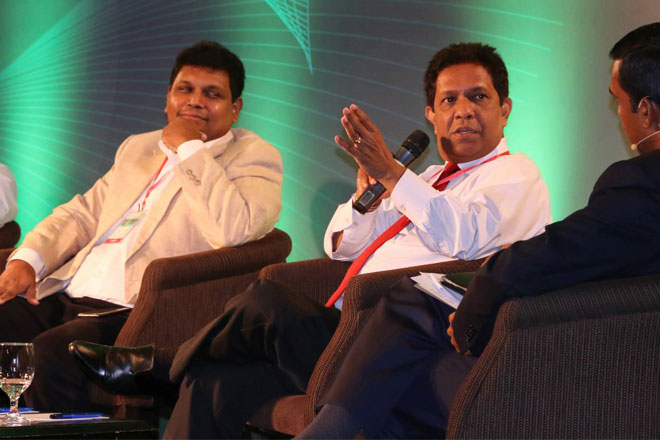Sri Lanka’s banking Industry should adopt new tech before it gets isolated: Aravinda Perera

July 27, 2015 (LBO) - Sri Lanka’s banking industry should make use of digital technology to improve customer service and to be on par with the competitive global payment industry, one of its banking leaders said.
In today's world it is not only a bank playing in the payment industry but also telcos, supermarkets and many more.
“So I think banks should adjust themselves to be in line with the changes that are going to happen, and be in partnership, work together with other possible alliances to make this change happen,” Aravinda Perera, managing director of Sampath Bank, said.
“Make use of what is happening around the world and make sure you are there, otherwise you will be redundant.”
Digital technology has made many disruptions and welcomed many new trends over the last couple of years and the payment industry keeps evolving and adapting to keep pace.
Perera says, with technology developments an entity would not make massive profit in being different or try to disrupt the industry with a novel idea, because the others will follow you quickly.
“At Sampath, we have made lot of disruptions in the banking sector. In the earlier days disruptions were profitable. But now the problem is, when you come up with a disruption, the duration between you coming on screen and others coming on screen is very short.”
“I don’t think any single player can make a big profit out of that.”
McKinsey & Company, a global management consulting firm had forecast in a research report says that after the financial crisis of 2008, the payments revenue will grow by eight percent each year through 2018, at which point annual revenue will reach 2.3 trillion dollars and account for 43 percent of all banking-services revenue, compared with 34 percent in 2009 (exhibit).
According to the report the growth of adoption of smartphones and tablets, leading to a convergence of the offline and online world, further opening the value chain to innovative outsiders, large and small.
McKinsey research forecasts that more than 50 percent of incremental revenue in almost all banking products in Western Europe will be digital by 2018.
The next challenge for payments providers is developing a deeper understanding of customer needs and behaviors—both in the banking and non-banking facets of their lives.
So is Sri Lanka sill in the Dark Age?
The world today moves towards a cashless society which will simultaneously decline the growth of conventional banking.
Digital services such as e-money accounts linked to debit and pre-paid cards are also emerging which will give an option to traditional banking.
In developed countries, people rarely walk in to a bank.
“There is really a long way to go for banking industry and the other industries are going to move much faster,” Ajit Gunewardene , deputy chairman of John Keells Holdings PLC said.
“As an example, it is such a hassle to open a bank account in Sri Lanka. I can’t figure out why we need to go through that whole process, simply to open a bank account,”
“Today you got bio metrics. You can sit at home and open an account and technically no one can create a fraud around that,”
“Simple things of that nature need to happen.”
In information technology, biometrics refers to technologies that measure and analyze human body characteristics, such as DNA, fingerprints, eye retinas and irises, voice patterns, facial patterns and hand measurements, for authentication purposes.
ICT expertise argues the banking industry is held back due to tight regulatory frame work and customer reluctance to adopt digital products.
“Most of the disruptions are happening in the industries that are not regulated,” Mani Kulasooriya , co-founder and chief executive of Leapset said.
“The banking industries are protected by regulation and for some extent they have been held back at a much higher level than the non-banks,” Mani Kulasooriya , co-founder and chief executive of Leapset said.
“But I don’t think any industry is safe if you are not regulated. But if you are regulated, you got few more years.”
To move ahead with world’s digital adaptation, the people or the customers also should be ready to accept the change.
“Fundamentally regulators are protected with a view of protecting citizens,” Muhunthan Canagey
chief executive of ICTA said.
“But is that the only question? he asked.
“When we take cash, we had it physically those days and today we are talking about virtual currency,”
“With regard to payments, do we need to go to ATM’s or do we need to go to banks or outlet? No you do not need that,”
“So technology is not the only issue across, but also the mindset,”
“We have to see the legal frame work and existing frame work and see whether the people are ready to adopt and comfortable in doing so.”
Perera said apart from legal frame work, speed connecting frequencies also needed for banking industry to adopt digital.
Accordingly an infrastructure of a county would play a major role in going digital.
“We are looking at a wearable bank for 2020.”
“In wearable banking, you might be in Pasikuda , enjoying the beach wearing your spectacles and when you blink twice, your bank will come and do a retina scan and identify you, Then you will be connected immediately with person to assist you to make your transaction,”
“These types of products would come and it will be a wide open space for anybody who will like to play in the payment industry,”
“So the banks should be ready.”

Can you please post the full video of this conference?
https://www.youtube.com/user/lbrlbo/videos